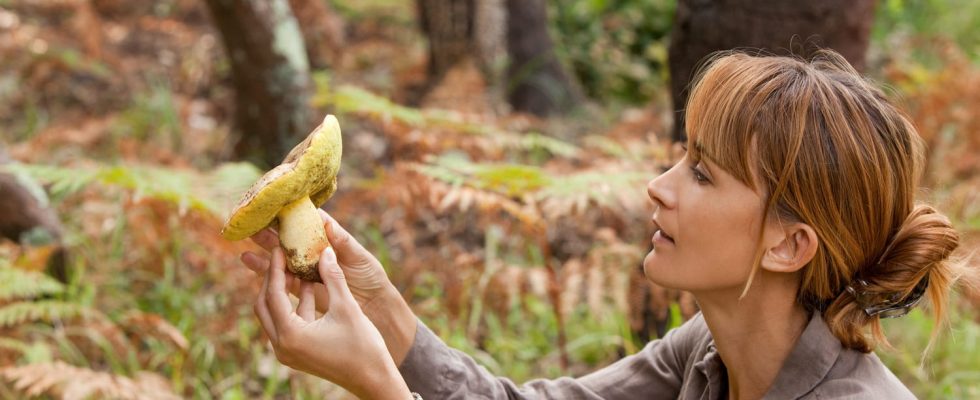In the forest, some highly toxic poisonous mushrooms closely resemble edible species. Among the warning symptoms of poisoning: diarrhea, vomiting, nausea and sometimes vision problems…
This year, mushroom picking started early. Since August 1, 2023, poisonings reported to Poison centers increase: more than 250 cases have already been identifiedor twice as much as in 2022, reports the National Medicines Safety Agency (Handles) in a press release dated August 31. “Whether you are a connoisseur or an occasional picker, stay vigilant and follow good practices for safe consumption.”
What precautions should you take when collecting mushrooms?
- Only collect mushrooms that you know perfectly: some Highly toxic poisonous mushrooms closely resemble edible species.
- Collect only specimens in good condition and remove the entire mushroom (stem and cap) to enable identification.
- Do not pick mushrooms near potentially polluted sites (roadsides, industrial areas, landfills).
- Separate the mushrooms carefully by species harvested to avoid mixing pieces of poisonous mushrooms with edible mushrooms.
- Place the mushrooms separatelyin a box or cardboard box, but never in a plastic bag which accelerates rotting.
- Do not consume mushrooms identified solely by means of a recognition application of mushrooms on smartphone, due to the high risk of error.
- Photograph your harvest before cooking.
► After picking:
- If there is the slightest doubt about the condition or identification of one of the mushrooms harvested, do not consume the harvest before having it checked by a specialist. Pharmacists or mycology associations and societies in your region can be consulted.
- Wash your hands thoroughly after harvesting.
- Generally speaking, mushrooms should be eaten in small quantities, well cooked.
- Never eat wild mushrooms raw.
- Never feed mushrooms you have picked to young children.
- The cooking time for the mushrooms varies depending on the mode (20 to 30 minutes in the pan, 15 minutes in boiling water).
What to do if in doubt about a mushroom?
Beware of digital applications that offer recognition systems. They are not always reliable. If you have the slightest doubt about the identification of one of the mushrooms harvested, do not consume the harvest before having it checked by a specialist in the field: pharmacist or mycology association. The MycoFrance association lists the list of poisonous and edible mushrooms. ANSES recommends taking a photo of the mushrooms before cooking them: it could prove useful in the event of food poisoning. To note that the base of some mushrooms is not always edible.
► Store the mushrooms in the refrigerator (maximum 4°C) avoiding contact with other foods and consuming them within two days after picking.
► Consume mushrooms in reasonable quantities after a sufficient cooking (20 to 30 minutes in a pan or 15 minutes in boiling water) and never eat raw wild mushrooms.
► Never offer picked mushrooms to young children. Make sure they do not put a mushroom found in the garden or schoolyard into their mouth.
Mushrooms should always be well cooked. For the preparation of edible mushrooms, a cooking for at least 15 minutes is recommended to destroy microorganisms and parasites likely to contaminate the picking or harvest. All mushrooms with a raw toxic character, that is to say containing a heat-labile toxin, must be cooked in a pan for 20 to 30 minutes so as to reach a core temperature of 70°C or boiling water at 100°C for 15 minutes. In this case, it is recommended to discard the cooking water. For consumers, it is recommended to consume the mushroom in perfect freshness, and in reasonable quantity and frequency, 150 to 200 grams of fresh mushrooms per adult per week.
What are the symptoms in case of poisoning?
The signs of poisoning can be more or less serious depending on the type of mushroom consumed and the quantity ingested. These are often digestive disorders (diarrhea, vomiting, nausea), sometimes tremors, dizziness, vision problems, liver damage which can be fatal in some cases. “Symptoms usually begin to appear within 12 hours after consumption and the intoxicated person’s condition may worsen rapidly.“, indicates ANSES on its website.
What to do in case of poisoning?
If you notice the appearance of one or more of these symptoms following the consumption of mushrooms collected in the wild, immediately call 15 or 112 or poison Control Center closest to you. It is very important to mention to your interlocutor that you have consumed mushrooms, specify the time of the last meal, the time of onset of the first signs as well as precisely describing the symptoms.
Two reflexes: Photograph your harvest before cooking! The photo will be useful to the toxicologist at the poison control center in the event of poisoning, to guide you towards the most appropriate treatment. And save the leftovers from the harvest to allow better identification of the species.
Poison Control Center numbers 24/24 – 7/7 | |
|---|---|
| ANGERS : 02 41 48 21 21 | MARSEILLE : 04 91 75 25 25 |
| BORDEAUX : 05 56 96 40 80 | NANCY : 03 83 22 50 50 |
| LILLE : 08 00 59 59 59 | PARIS : 01 40 05 48 48 |
| LYON : 04 72 11 69 11 | TOULOUSE : 05 61 77 74 47 |
